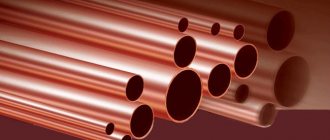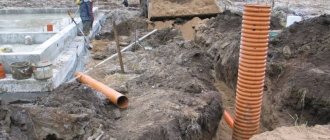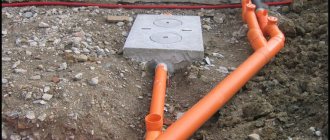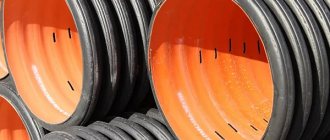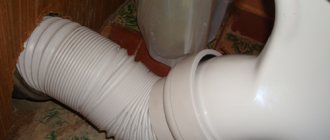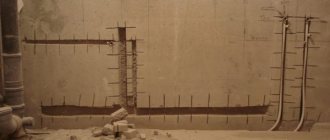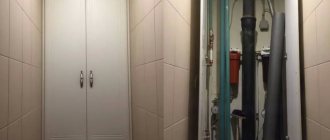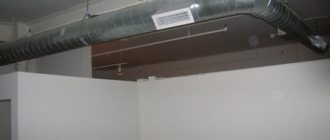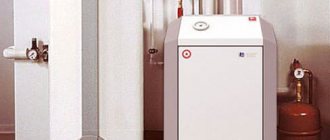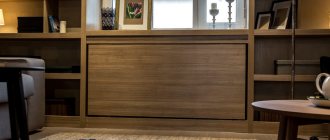- Main split system
- Laying copper pipes
- How to cut copper pipes correctly
- Flaring pipe ends
- Thermal insulation of the system after replacing pipes
The whole difficulty of installing an air conditioning system lies in the installation of the external part of the structure. It takes a lot of time and requires a lot of effort. Replacing air conditioner pipes is quite a complex and painstaking job that requires special attention.
The process of fastening the structure of the external unit, cleaning it or replacing parts is carried out using a car tower or special climbing equipment. The performance and service life of the equipment depend on the correctness of the work performed, so doing this work yourself is extremely difficult and is not recommended. Professional specialists have the skills and experience of working in such conditions, therefore, they will cope with the task much faster and better.
Air conditioner external unit
Let's look at some recommendations that should be followed when installing the external part of the air conditioning system:
- The external unit is quite heavy, so it is advisable to use brackets. They can support the weight of the block with an additional double margin. Only a well-fixed device can withstand strong gusts of wind and other adverse natural conditions;
- The device is mounted only in a horizontal position;
- Fastening to the brackets must be carried out using a certain type of bolts;
- For anchor bolts in the wall, holes are prepared in advance, for drilling which it is necessary to use a hammer drill;
- The user instructions, which should be included with the equipment, indicate the distance that must be maintained between the unit and the wall. The minimum value of this figure is at least 20 cm;
- It is necessary to ensure that another external part from another device is not located above the block, and that no protruding part of the building’s façade structure hangs over it;
- All communications must be well recorded;
- There should be no sources of thermal energy or ventilation outlets near the unit;
External unit on the roof - When placing the unit on the roof, you need to take into account that the distance from the roof to the device should be more than 25 - 30 cm;
- Some kind of canopy is needed over the block; a regular roof canopy will do, which will protect it in adverse weather conditions.
Functions of the drainage system
To remove condensate that appears on the evaporator of the indoor unit during gas conversion and cooling, there is a drainage system. In essence, the drainage is a tube in which condensate is removed from the air conditioner. At the same time, the system consists of several components: a tray, connecting pipes and a pipeline.
Before installing climate control equipment, you should understand that there are two types of drainage systems:
- Gravitational;
- Forced.
In the first case, moisture accumulates in the tray, then naturally, according to the laws of gravity, flows down the connected tube into the sewer or directly onto the street. This type of drainage is the most common in an air conditioning network.
The artificial system includes the use of a drainage pump. Its use is justified in two cases: if it is necessary to supply moisture upward or the condensate drain pipe is too long and the liquid cannot flow naturally.
How to isolate the route?
To solve the problem, you can use materials from different manufacturers. The most relevant is the following thermal insulation:
K-FLEX insulation is a flexible elastic material. It is made from special raw materials - closed-cell foam rubber. The thermophysical and operational characteristics of this thermal insulation are of high quality. Low thermal conductivity and vapor permeability make the use of this material very convenient. The insulation is durable. It has a high level of sanitary, fire and corrosion safety.
The products are considered one of the best on the market. Its manufacturer has an impeccable reputation among consumers. K-FLEX thermal insulation is one of the most reliable and effective. It is ideal for insulating air conditioner pipes.
Energoflex insulation can also be used to solve the problem under consideration. The range of products of this brand is very wide. The company produces thermal insulation from foamed polymers, especially for air conditioning systems. The material is characterized by a closed-cell surface. It provides a decent level of moisture protection and vapor permeability.
Condensate drain options
There are several options for condensate removal, that is, methods for draining air conditioners. The simplest one is to make a hole in a wall or window and pass a hose through it to the street, which at one end is connected to the pipe of the bath located under the evaporator of the indoor unit of the unit. It is the simplicity of the operations performed that is considered a big advantage of this method.
But it also has negative sides:
- a hose hanging from the side of the wall does not in any way increase the presentability of the appearance of the building, especially for a private house;
- Water will constantly drip from the free end of the hose while the air conditioner is operating, which, if it gets onto the adjacent window sill (lower), will lead to a scandal with the neighbors.
The second option for draining condensate is to connect the drainage pipe to the sewer. The method is ideal for many rooms, but it has one big problem - the lack of a sewer section in the room where the indoor air conditioner unit is installed. Way out:
- Install sewer pipes into this room with a slope of up to 3%.
- Install drainage pipes to the nearest sewerage section with the same minimum slope.
Which option for draining condensate from the air conditioner into the sewer system is up to everyone to decide for themselves. But it is necessary to indicate that the lowest costs, both in terms of finances and in terms of the labor intensity of the work carried out, belong to the second method. Firstly, drainage pipes can be laid both inside the wall along the grooves made, followed by sealing with repair solutions, and along the floor base, followed by finishing.
Secondly, any sealed hollow products can be used as drainage tubes. More often, a corrugated pipe of small diameter is purchased for this.
Attention! To prevent unpleasant odors from penetrating into the premises from the sewerage system, a water seal in the form of a conventional sewer siphon is installed at the junction of the drainage pipes and the sewerage system pipes. If it is not possible to install a siphon, then the corrugated tube is bent in the shape of the letter “S”. Also an effective option.
And one moment. If the air conditioner is not used for a long time, the water seal dries out, which leads to the penetration of unpleasant odors from the sewer. Therefore, periodically it is necessary to pour a little water into the drainage system. And this is probably the only disadvantage of this method.
The third option for condensate removal is the installation of a special pump. This drainage method is used only in two cases: the drainage system is long and there are differences in it. In household air conditioners, pumps are not included in the package, although they are sold as a separate element, and purchasing it and installing it will not be difficult. In almost all industrial units, drainage pumps are installed at the factory.
Conclusions and useful video on the topic
The following video will introduce you to the features of the system for draining condensed water during operation of the air conditioner:
When installing climate control equipment, it is necessary to take into account the features of the air conditioner drainage system. If the split system pipes were laid correctly and a water seal was installed, the operation of the unit will not cause inconvenience to anyone. It is better to decide where to dispose of condensate at the stage of designing the route and locating the blocks.
Would you like to talk about your own experience in organizing drainage for climate control equipment? Do you have information about an interesting and practical solution to a problem? Please leave comments in the block form below, ask questions, share your impressions and photos on the topic of the article.
Requirements for installing an air conditioner drain system
The requirements that the air conditioner drainage system must meet basically repeat the requirements for laying sewer systems:
- The slope of the horizontal sections is about three percent.
- Rotation angles are no more than 45 degrees.
- If drainage is connected to a sewer system, a siphon with a water seal must be installed in front of it. The water standing in it will prevent the penetration of miasma from the sewer into the air conditioning system. When discharging condensate to the street, this requirement does not apply.
Price difference
The cost of copper is constantly growing and depends on the exchange rate. The decrease in the quantity and quality of the mined metal, its increasing shortage, contribute to the constant rise in prices for copper products. Therefore, the issue of finding an alternative that can replace copper in the production of air conditioning systems is one of the most pressing.
Aluminum has only recently begun to be used in cryogenic equipment (refrigerators, car air conditioners). The cost is stable and almost three times cheaper than copper; there are large reserves in nature. This opens up great prospects for the industrial production of products from this metal.
Drain pipes for air conditioners
The drainage tube of the air conditioner, with the help of which the condensate formed inside is removed from the air conditioner, is made of polyethylene or polyvinyl chloride. These materials are resistant to water, and products made from them are highly durable. In practice, manufacturers equip air conditioners with two types of reinforced tubes - smooth and corrugated. Smooth tubes are most often found in budget air conditioner models. Their installation is impossible without special fittings.
Fittings are an element used to form bends when laying pipelines for various purposes.
The use of smooth pipes with fittings for laying a drainage pipeline is advisable when the air conditioner is located in close proximity to the sewerage system. If the point where the tube connects to the sewer is located at a sufficiently large distance, the use of fittings significantly complicates the installation of the pipeline.
Flaring pipe ends
When installing an air conditioner and laying a line, return nuts and fittings are used to connect copper pipes. As a rule, each split system is equipped with shutters. They are located at the connection points of the tubes.
Copper tubes
To screw a nut onto a pipe made of copper, the ends of the pipes must be flared. To do this, you will need a tool - a rolling tool and a small vice, which should be included with the rolling tool. Principle of operation:
- The return nut fits onto the end of the pipe;
- Leave a small indent from the edge and pipe and clamp it with a vice;
- Then we bead the pipe;
- After this, you need to compare the obtained data with the indicators in the table, which indicates the necessary parameters of the tube to be beveled.
The beading process must be carried out very carefully to avoid damage to the pipe. But, if it was not possible to avoid damage, you need to cut off the damaged end of the pipe and repeat all the work.
Installation of air conditioner drainage system
Most often, a joint route is organized between the air conditioner units, where, in addition to drainage, installation of other communications is carried out.
If the drainage hose is not made of frost-resistant and wear-resistant material and has a small diameter, then it is useful to hide the drainage line in a corrugated pipe in an outdoor area. There is no point in doing this indoors.
Upon completion of the installation of the air conditioner drainage system, or rather the drainage pipe, the communications of the joint route should be secured together with electrical tape in several places, unless a corrugated pipe with a large diameter serves as an insulating winding. Communications should not be connected in advance to the indoor unit of the air conditioning system.
Drainage of an external unit with an outlet to the street is simple: a flexible hose is connected to the drainage hole located at the bottom of the unit, the outlet of which is positioned so that condensation does not fall on neighbors’ windows, facade ledges and other air conditioners.
When the installation of the air conditioner drainage system is completed, all its parts will be connected, the general communication route laid along the external wall of the house should not be forgotten to be wrapped with electrical tape, or to use another insulation method in the form of a corrugated pipe.
The electrical tape must be wound from bottom to top. The same procedure should be applied to copper pipes in exposed areas and electrical wiring to protect them from corrosion. The hole made in the external wall should be securely filled with silicone sealant.
Step-by-step instructions for installing an air conditioner drainage system
The step-by-step instructions for installing an air conditioner drainage system are very simple.
- It is necessary to remove the lower fasteners from the air conditioner body so that it can rise.
- In the lower part, under the fan that blows the evaporator, there is a tray for collecting condensate.
- There is a pipe on its side, and it is to it that you need to attach the drainage pipe for removing condensate from the air conditioner using a clamp.
- The housing of the indoor unit is lowered and installed in place. In this case, it is very important that the corrugation passes through it through a special hole made in the side wall.
- The fasteners are screwed into place.
Kinds
Pipes for air conditioners are classified according to several parameters.
Main types depending on:
Technologies for their production:
- cold-deformed pipe products;
- pipes for air conditioners made by welding with further hot tempering;
- pressed.
Technological processing:
- hardened;
- hardened;
- semi-hardened;
- anodized;
- artificially aged;
- naturally aged.
Section shapes:
- square;
- rectangular;
- round;
- shaped.
Wall thickness:
- thin-walled (up to 5 mm);
- thick-walled.
Round aluminum pipes
Basic air conditioner malfunctions
One of the most common malfunctions of any air conditioner is its leakage. This defect most often occurs due to clogging of its drainage system. In this case, the hole in the pan, intended for draining condensate, becomes clogged with dust and debris brought by the water flowing into it. As a result, the pan overflows and water begins to flow out, bypassing the drainage system.
Disruption of the drainage system also occurs for other reasons:
- If there is insufficient refrigerant in the system, the temperature of the heat exchanger decreases, which leads to the appearance of ice on its surface. The flowing water does not fall into the pan, but flows out onto the floor of the room.
- If the air conditioner does not have a pressure regulator or is faulty, when the outside air temperature drops, the pressure in the system drops. At the same time, the temperature of the refrigerant in the evaporator also decreases and icing occurs.
- When using the air conditioner in the cold season, the outlet of the drain pipe may freeze, which will cause the drain pan to overflow with water.
- Errors when installing the drainage system: lack of slope when laying the pipeline, “dry” water seal, poor-quality drainage pipes, depressurization of connections, “pseudo-siphon” device, etc.
- Failure of the drainage pump or clogging of its float chamber, causing the pump to stop working.
If problems arise related to a drop in refrigerant level, a decrease in pressure, failure of the drain pump and other malfunctions, the right solution would be to contact a specialized service center. Their qualified specialists will quickly and efficiently eliminate faults.
Benefits of use
- The aluminum pipe for installing air conditioners bends well, without creases, and requires less effort. The same tools are used as when working with copper.
- low melting point. This makes soldering of elements faster (4 times), significantly saving time, gas, and soldering rods. There is no need for additional equipment, turning seams, etc. The welding seams are much stronger than the metal itself. The blowtorch and gas are the same as for copper.
- due to greater softness, less effort is spent on pipe flaring, the set of tools is the same. The strength of the pipes is ensured by their greater thickness.
- expansion up to 30%.
- thermal conductivity characteristics are almost two times lower than those of copper. This contributes to lower condensation of pipes in the system.
- corrosion resistance is higher, the oxidation reaction rate is lower. This will keep the inside of the cryogenic system pipes clean for a longer time.
- wide temperature range from -80⁰ C to 120⁰ C.
- aluminum pipe for installing air conditioners is lighter, so it can be delivered in 50- and 100-meter coils. This reduces the amount of waste, welding seams and reduces the likelihood of leaks.
Results
Installing an air conditioner is not as simple a task as it might seem at first glance. Installation is time-consuming and requires the installer not only to have tools, but also certain knowledge. However, even before installation, it is important to choose the right components so that all the work does not go down the drain.
Today we shared our opinion about copper pipes. About their advantages and disadvantages, features of selection and installation. There are always disputes between installers and home craftsmen about components. In this article, we told you which copper pipes fall under our quality criteria and how to install them correctly.
Still have questions? Ask them in the comments below. Also read other articles on our website and share them on your social networks. Good luck!
